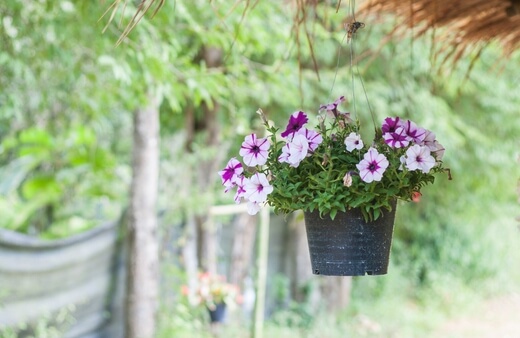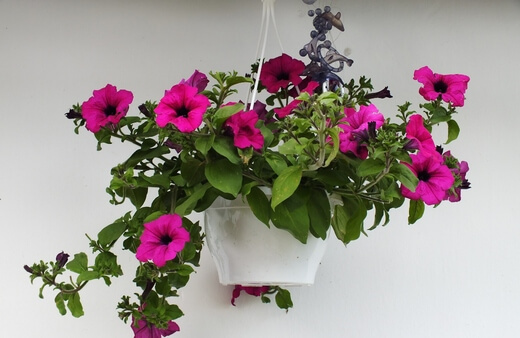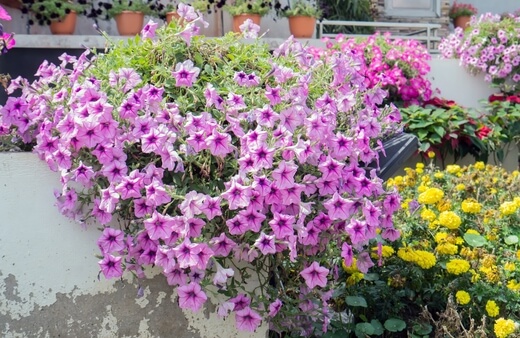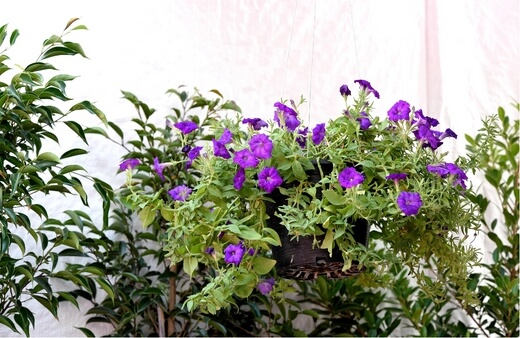The biggest appeal of growing petunias is the wide range of flowers, with colours to suit every palate and brighten up any patio or border. In this guide, I’m going to share everything I’ve ever learned about petunias, some from practice, and some from my grandfather, who religiously grew petunias in every corner of his garden.
Whether you’re on damp clay soil or free-draining sand, in a climate with hot, arid summers or cold humid winters, you will be able to grow stunning petunias all year round, in pots, in borders, and in hanging baskets. Follow this guide and decide what’s right for you.
More...

Family: | Solanaceae |
|---|---|
Genus: | Petunia |
Species: | various |
Common Name: | Petunia |
Location: | indoor or outdoor |
Type: | Tender herbaceous perennial |
Growth: | Up to 40cm x 40cm |
Sun requirements: | Full sun to part shade |
Foliage Colour: | Green |
Flower Colour: | All |
Flowering: | All year |
Fruit: | None |
Maintenance level: | Medium to high |
Poisonous for pets: | Non-toxic to cats and dogs |
What are Petunias?
Petunias are herbaceous perennials, but they are also tender plants that will not recover from freezing or near-freezing temperatures. For that reason, choosing where you grow them and how, really does matter.
They are closely related to nicotine, or tobacco plants, which have similarly bell-shaped flowers, and a remarkably similar fragrance. Although petunias emit most of their scent during the day, as opposed to tobacco, which pumps our sweet aromas in the evening.
In cooler parts of the country, petunias are often treated as annuals, as they are simple to propagate and tend to flower best in their first year anyway (meaning it can often be worth sowing new plants each year regardless of climate).
In our gardens, we typically use petunias in hanging baskets, but they are longer lived in the ground in most Australian gardens, where they form dense mounds of flowering herbaceous plants, most of which will regrow for several years – more similar to their native environment.
Petunia's Natural Habitat
There are twenty accepted species in the genus Petunia, and all are native to South America. They grow in open spaces on well-drained soils and are used to heavy rain, which drains off quickly in a climate that can change from very humid to very dry in a matter of days.
Different Types of Petunias to Grow in Australia
There are four distinct types of petunia plants you can grow in Australia, and each is made up of a small group of distinct species, and hundreds of different and unique cultivars, with subtle differences in colour, fragrance, size, and care needs.
Grandiflora petunias
Grandiflora petunias are the most common garden type, with large blooms, often opening out to 12 cm or more. Often growing as ground cover in mounds of over 1m across in a single year of growth, they are rapid plants to grow, especially for hanging baskets and pots where they can have their full impact.
Multiflora petunias
Multiflora petunias have a much more compact habit typically only growing to about 20 cm across. Their main appeal is for the more vivacious garden designs, allowing for multiple colours and varieties to share a single pot, making wild and colourful displays of densely flowering herbaceous perennials. They look best either as groundcover or in pots.
Milliflora petunias
Milliflora are smaller again, and the smallest types of petunia you can grow reliably at home. They require really good drainage and benefit from a layer of bark chips around their base if grown in the ground to prevent puddled water from touching their leaves.
Spreading petunias
Spreading petunias make the ideal ground cover. They are only about 15 cm tall but can cover several metres of ground in a single season. They can be sown densely and directly in prepared beds, or grown from seed indoors to get them started in cooler regions.
Growing Petunias in Australia
Petunias grow best in bright but indirect light, with well-drained but rich compost. In hanging baskets and pots, they require slightly higher water retention, and in the ground, they need regular irrigation, but good drainage.
Depending on where you live, or how you grow them, the conditions do differ slightly, so follow the guide below for more in-depth information on planting petunias.

How to Propagate Petunias
To begin with, you’ll need to decide how you’re going to get started. Petunias are relatively cheap to buy as young plug plants in winter and spring but will grow all year round, so you can often get a head start by sowing them early in the year, or taking cuttings.
Propagating Petunias from Seeds
To grow petunias from seed, you’ll need a loose, free-draining compost mix (any sandy soil with vermiculite will work well, or sieved compost by itself).
- Fill a modular propagator with your potting mix.
- Sow one petunia seed into each module.
- Add 1 cm of water to the base of the tray, and leave for one hour.
- Drain the tray when the soil is saturated.
- Cover your propagator and leave it somewhere warm and bright.
- Germination will take 7-14 days.
- When each module has small plants with several leaves, you can gently prick them out (the roots should be well formed and come out easily)
- Plant each seedling into an 8-10cm pot, filled with good compost.
- Acclimatise your seedlings outdoors if they were started indoors for a week or two, while they develop.
- Plant into the ground or baskets, and care as normal.
Petunia Propagation from Cuttings
Cuttings are a more reliable way to get exactly the same plant next year. If you loved your petunias this year, saving the seeds can result in slightly different plants due to cross-pollination.
To take petunia cuttings:
- Choose a healthy and dense petunia, with plenty of fresh growth.
- Cut about 15cm of a non-flowering stem, and strip the lower leaves.
- Trim the base of your cutting to just below a node.
- Dip the cut in rooting hormone (powder seems to work best).
- Lay your cutting so the margin of the stem is inside the pot (8-10cm round plastic pots work best)
- Gently fill around the cutting with a mix of sieved compost and vermiculite, tamping gently to remove air pockets.
- Water well and leave somewhere cool and shaded for three to four weeks, misting the surface if the soil dries out.
- When your stems develop new shoots, plant them into new baskets, pots, or even into the ground.
Best Conditions for Planting Petunias
You can plant petunias in the ground, or in pots and baskets, depending on the look you’re after, or your soil conditions. Follow the guides below for basic petunia planting tips for both situations.

Soil & Drainage
If planted in the ground, petunias need excellent drainage and regular irrigation. Avoid clay soils, or plant into raised beds or pots with better drainage. If you have exceptionally sandy soil, with no water retention, enrich it with garden compost or leaf mould.
Water
One of the only true challenges of growing petunias is balancing their need for drainage with their need for moisture.
In tropical regions of Australia, Petunias may need to be watered daily through summer. In cooler regions, they can get away with two waters per week before they start to look stressed.
Light
Petunias need plenty of bright light, but it can be beneficial to shade them from extreme heat and midday summer sun. We’ve got a directly North facing garden, and our petunias grow well in direct light in the ground, but suffer in pots as the heat dries the soil out too quickly.
How to Grow Petunias in Pots
Petunias in pots or hanging baskets need added water retention. You can do this by adding chunky compost to the mix, coco chips, or silica-based moisture retention crystals.
Aim to avoid full afternoon sun where possible, as this will increase how often you need to water your petunias.
Caring for Petunias
Fertilising Petunias
Petunias need a lot of nutrients to produce the stunning blooms we know and love. You can use anything from tomato food to slow release granules, provided it has a reasonably balanced NPK ratio (Nitrogen, Phosphorous, and Potassium).
As soon as you plant petunias into a new pot or basket, regardless of the soil you’ve used, give them a good drink with a cap full (or sprinkle) of fertiliser. Petunias in pots are a good candidate for fertiliser capsules and drip feeds too, which slowly release the nutrients they need as and when the soil needs it.

Pruning and Deadheading
Regularly deadhead your petunias to stop them from becoming messy. Petunias will naturally deadhead if they aren’t pollinated, but you should manually remove flowers once a week to keep them blooming, and prevent seeds from forming.
Any dry growth is expended, and won’t recover, so prune it out regularly to encourage new fresh growth.
Common Petunia Pests and Diseases
Petunias do suffer from quite a few common garden pests, especially when planted in the ground. Petunias in hanging baskets are rarely affected, and those in pots tend to suffer from common care-related ailments like root rot, then fungal or bacterial infections.
However, there are some pests to look out for:
Petunia Pests
Possums and marsupials
Perhaps the worst pests for petunias are marsupials. Despite their bitter taste, petunias make an attractive meal for possums and most other native marsupials. It’s rare that they will make a trip specifically to your petunias, but for some reason, once they’re had a taste, they do tend to eat the whole thing.
Other than pepper or chilli sprays, there’s not much you can do to prevent the damage from happening other than chase them off. To make a basic chilli spray for your vulnerable plants, mix a handful of chopped chilli with a litre of warm water and leave it to sit.
Strain the mixture and add a few drops of dish soap to help it stick, then spray it over your plants in the morning.
Slugs & Snails
Slugs and snails will devour petunias, but thankfully they are quite slow eaters. Encouraging birds, toads, and slug predators into the garden will help to reduce your slug trouble, and mixing up a garlic spray (similar to the chilli spray above) can be an effective deterrent.
Budworm
Tobacco budworms are a common petunia pest and will damage tobacco plants, geraniums, and petunias in equal measure. They are actually the caterpillars of the Heliothis virescens moth and can be hard to spot against the matching green leaves.
If you notice holes in the buds of petunia, it will stop them from flowering and will often cause other fungal problems that can spread back down the stem. Take some time to remove any caterpillars you can by hand, and either put them on the bird table or find a less offensive home for them at the back of the garden.
Leaf miners
Leaf miners are my favourite garden pest but they can cause a lot of damage to your ornamental plants, petunias included. They burrow into leaves, and eat away at the veins, creating beautiful patterns across the surface of the leaf when held up to the light.
They rarely cause fungal problems (although it does happen) but do damage the leaves, as water and nutrients aren’t able to reach the tips of the leaf, and they will eventually turn brown around their borders and drop off.
Remove all fallen leaves as they have little benefit as mulch, and bin them to prevent further spread.
Aphids, spider mites & thrips
Petunias are very susceptible to common garden pests, like aphids, thrips, and mites. They are easy to manage, either with organic pesticides like neem oil or by introducing ladybirds into the garden as natural predators.
Petunia Diseases
When it comes to disease, if it can affect tomatoes or tobacco, it can affect petunias. Thankfully, petunias only tend to suffer from these problems over winter, and stopping watering altogether will largely prevent them from happening.
Watering or wetting the leaves of petunias can cause powdery and downy mildew, and increase humidity to a point where botrytis blight can take hold. Other common problems include verticillium wilt and fusarium wilt, which are both signified by the formation of brown patches on the edge of a leaf border, followed by yellowing leaves and dropping stems.
Most can be treated by removing the affected growth, and treating the plant with a neem oil spray in the morning, then leaving the soil to dry out before watering again.Petunia Frequently Asked Questions

What month is best to plant petunias in Australia?
In warmer parts of Australia you can plant petunias at any time of year. In cooler parts of the country, it's best to plant Petunias in September for a long flowering season through spring and summer.
How do you keep petunias blooming?
Petunias bloom for longer if they receive good light, a little bit of shade from the afternoon sun, and plenty of fertiliser. But, most importantly, petunias can be kept blooming with regular deadheading.
What do you do with Petunias when they finish flowering?
When petunias have finished flowering for the year, they will appreciate a break. Cut them back by two-thirds to encourage new vegetative growth, and if possible, move them somewhere cooler and more shaded for a few weeks so they can have a period of dormancy.
Where do you pinch off petunias?
When deadheading petunias, the best place to pinch them off is back above the next leaf. By pinching back to a leaf, you encourage new growth, and new shoots, which will produce bushier growth and more flowers in a few days or weeks.
How do you revive scraggly petunias?
If your petunias have grown scraggly, leggy or looking otherwise sad and sparse, cut them back evenly on all sides, by about 1/3 on each stem. This will encourage new growth, and help to bush out your plants.
Do petunias do better in pots or in the ground?
Petunias do well in both pots and the ground in Australia, so deciding which is best for you will depend on climate, weather conditions, the orientation of your garden, and ultimately, what effect you want to achieve.
Why do my petunias look like they are dying?
Petunias need regular deadheading to stay neat. Their flowers will wilt and fade if left to develop seed, and the entire plant will look pretty sorry for itself. Deadheading will often be enough to revive a sad or dying-looking petunia.
How do you tell if petunias are overwatered or underwatered?
At first glance, the signs of overwatered and underwatered petunias are very similar – dry, yellowing foliage, and a lack of flowers, or even bud drop. Essentially, if those signs are accompanied by dry soil, they’re probably under-watered.
If they are accompanied by damp soil or mushy roots, they are overwatered.
Wrapping Up Our Petunia Growing Guide
Petunias work well in traditional gardens and modern gardens in equal measure. From matt-coloured blooms to splashy speckled petals, they offer something for everyone regardless of what you might think of them already.
Like most blousy flowers, petunias go in and out of fashion, but gardening isn’t about fashion, it’s about enjoying the space you’re in, and occupying it with plants that you adore. I can’t imagine a garden without petunias, and now you know how to grow petunias yourself, hopefully, you’ll feel the same way soon.
Published on February 14, 2023 by Maisie Blevins
Last Updated on February 23, 2024




